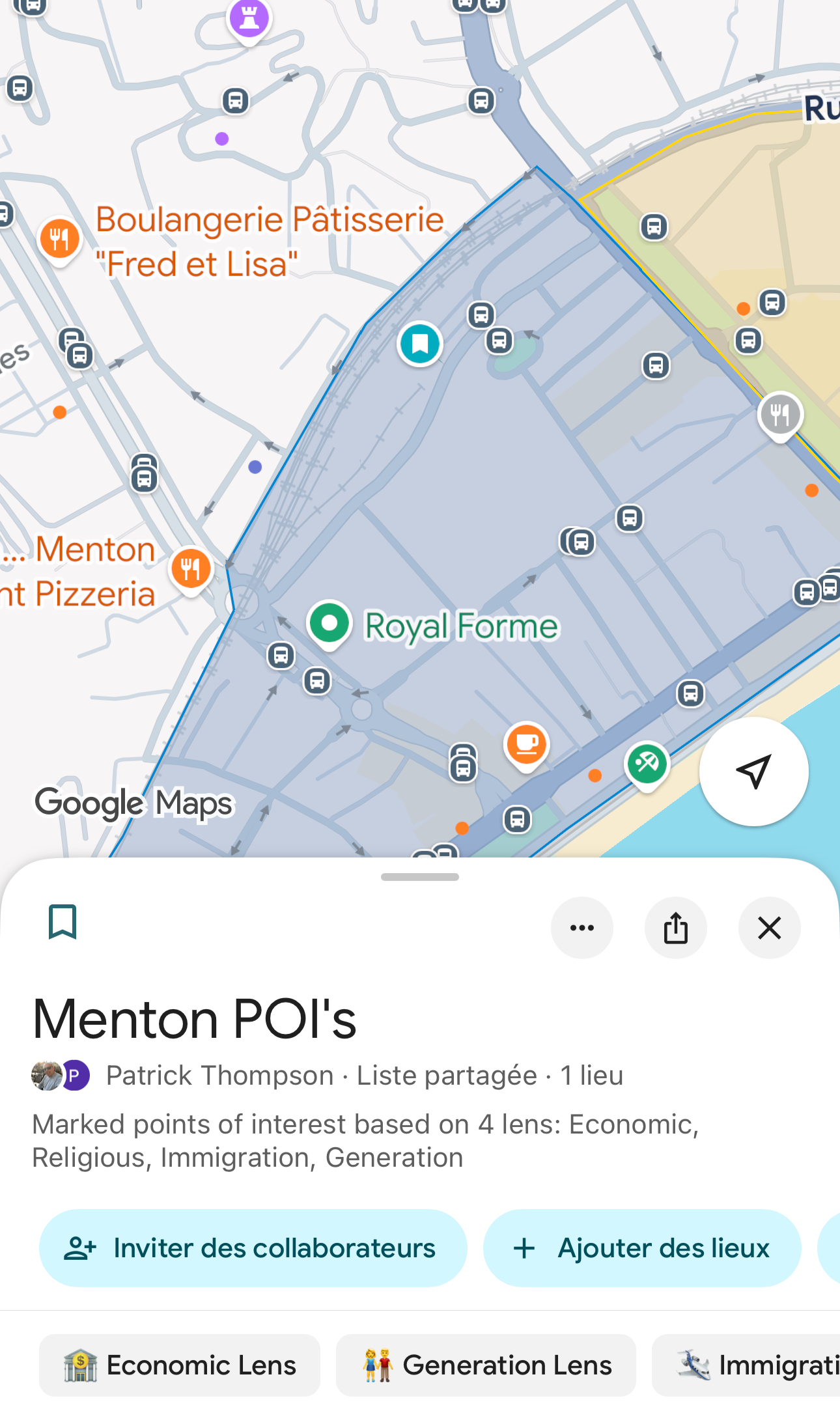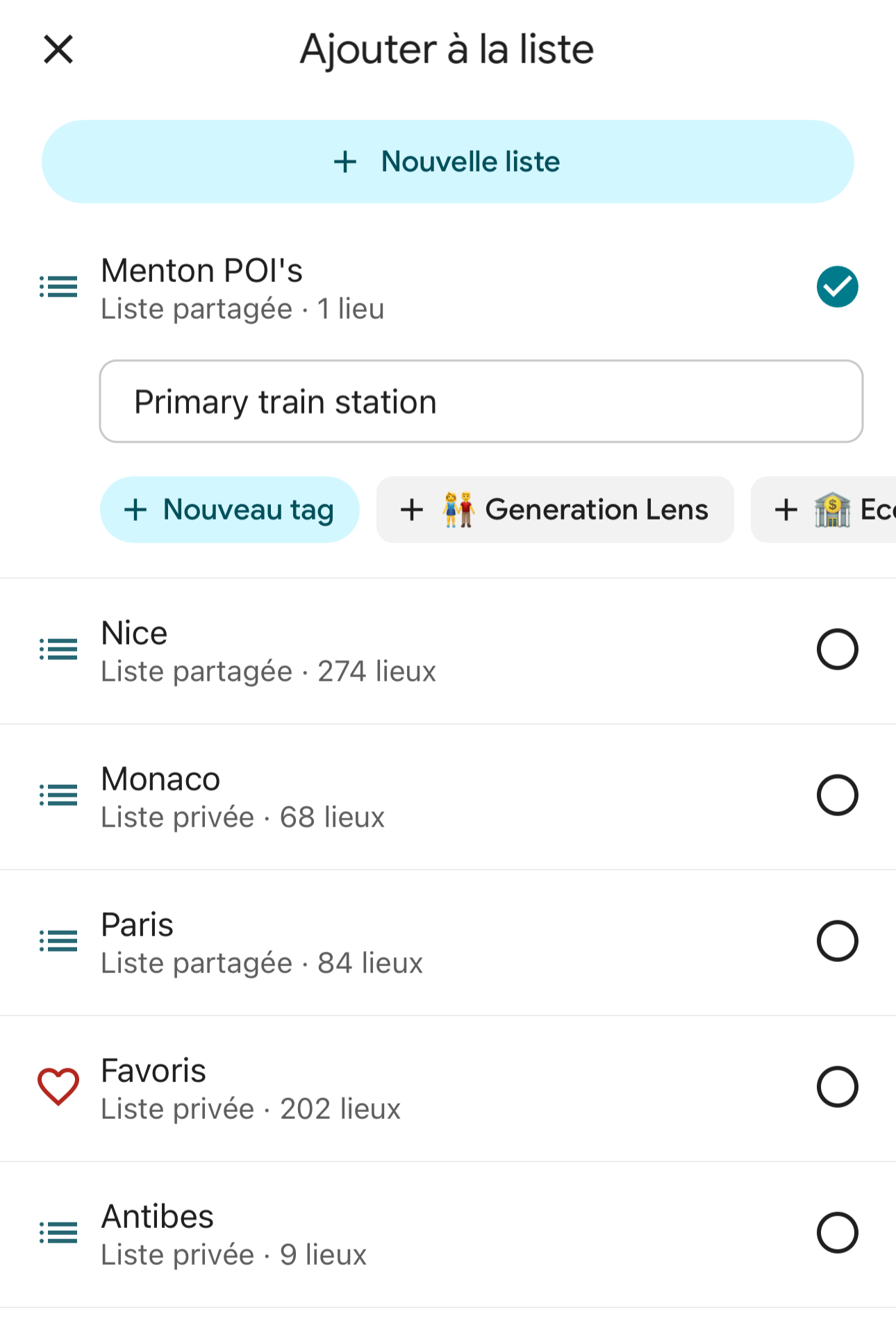MENTON MAPPING INSTRUCTION
Thank you for your willingness to help pray for our regions, discover people of peace, and engage gospel partners. You will be spending dedicated time in a specific area to help us determine the best ways to begin new relationships, bring gospel presence, and build healthy churches. Below are some basic instructions on engaging in the mapping process
KEY CONCEPT #1: ENGAGE YOUR ENTIRE AREA
EXAMPLE MAPPING AREA
Your team will be assigned a specific mapping area that will be one of the shaded areas on the shared google map. Your goal is to walk the entirety of the area and make observations along the way. This is not a race and the goal shouldn’t be to finish as fast as possible. Try to see the area both like a local and a tourist.
Keys to Good Observation:
Don’t rush!
Take the time to observe things like names of parks, streets, or buildings; they may give you some information about the area
If you find an interesting spot, take some extra time there, see if things change or if different types of people show up
It is okay to double back over an area, you may notice something different at different times of day
Look for landmarks, ask locals for directions and see what they tell you to look for
Don’t be afraid to initiate conversations with locals to see if they can give you insights you don’t see
Record as much information as you can as you are experiencing it.
KEY CONCEPT #2: ENGAGE YOUR AREA THROUGH DIFFERENT LENSES
You will look at your mapping area through four specific lenses. This will require you to walk your area multiple times. Walking an area with a specific lens on will help you notice things you might not have noticed before. If you have limited time you may combine 2 lenses, but make sure you keep both as a focal point. Below is a description of each lens.
Economic Lens (can be combined with Generation Lens)
Weakened - Those positioned in a prolonged vulnerable state due to avoidable and unavoidable life circumstances. Where do you see signs of homelessness, social services, food banks, low income housing, nursing homes, etc. Key idea: INTERDEPENDENT, these are people that need someone or some organization to help them with their daily needs.
Workers - Those positioned in a prolonged sustainable state that provides an adequate and stable lifestyle. This is the working class, those who make enough money to pay their bills, but maybe not enough to live at a level of ease. Where to you see signs of fast food, grocery stores, apartment building or row housing, public transportation, basic goods stores, etc. Key idea: INCOME DEPENDENT, these are people that need a regular paycheck to meet their daily needs.
Wealthy - Those positioned in a prolonged influential state that opens doors of power and control. This is people who have obtained enough wealth to sustain a life of ease. It is not necessarily those who own multiple homes, yachts or luxury cars. Think more along those who could take multiple vacations a year, live off investment income, etc. They may still work, but their income level provides them with enough leverage to accumulate most of what they desire. Key idea: INDEPENDENT, these are people that are more concerned with how to use their money instead of how to make it through the day.
Generation Lens (can be combined with Economic Lens)
Expectant (18-40 years old) - Those launching into adulthood and career. Look for places where college students, singles and young married couples may gather. Places like bars, parks, clubs, beaches, preschools, elementary schools. Where might they work or where would they go for social gatherings? Where is there a lot of energy and excitement?
Established (40-60 years old) - Those with established family and career paths. Look for places where families with teenagers, empty nesters, or older singles may gather. Places like more upscale restaurants, sports fields and venues, local markets, middle and high schools. You might find them in more established neighborhoods or along convenient transportation hubs.
Experienced (60+ years old) - Those older and with life experience. Typically they have adult children and have established some sort of life rhythm. However that rhythm may be changing as they age, life without kids, medical issues, lack of mobility, etc. Look for places like social halls, parks with areas for relaxing and social interaction, retirement centers or homes, cafes and bistros that might allow them to socialize in the afternoon.
Immigration Lens (can be combined with Religion Lens)
Settled - These are non-native born residents who have made the intentional decision to relocate their lives to France and embrace the culture and language. They have work or came here for work and plan on staying here long term. Look for markets that sell culturally specific food, ethnic centered restaurants, are these concentrated or spread throughout the area.
Seasonal - Those with a regular, voluntary and seasonal presence based on circumstances. They may have some or no grasp of language. These are often people who come to the region to work in tourism or seasonally specific jobs. Look at the type of works in hotels, bars, restaurants. Look around markets and piers to see those that might be working seasonally on farms or boats. Make a note of the languages you hear, and see if you can determine regions of origin.
Separated - Those who made an involuntary or reluctant decision to relocate to France based on extreme or uncontrollable circumstances. These could be those that came as refugees from global conflicts or desperate situations. Many are determining whether to reestablish life here or wait on an opportunity to return home. Look for those who maintain a strong cultural identification outside of France. Many times these groups of people congregate together in one area. See if you can learn how they are adjusting and what specific needs are.
Religion Lens (can be combined with Immigration Lens)
Places of Worship- Look for churches, synagogues, mosques, temples, etc. Try to determine what religions are active and present, look for specific labels like: pentecostal, baptist, catholic, traditional, orthodox, etc. See if you notice schedules or regular activities listed on site or online. Search for an online presence to determine if the congregation is active.
Places of Connection - Think if you were starting a church or business. Where would you go to let people know about your new endeavor? Where do large swaths of people gather regularly, places that would create an environment for relationship connections? Are there seasonal events that you can learn about that could be good for partnership? Where does the government or other civic organizations already connect with people on a regular basis (blood drives, concerts, arts, etc)?
Places of Ministry - Look for places that are already offering some kind of relief work. These could be through the local government or other charity organizations. What needs are they meeting, do they seem busy, overwhelmed or understaffed? What type of needs are they meeting, physical, emotional, financial, etc.? How open do they seem to partnering with other organizations or are they actively seeking volunteers?
KEY CONCEPT #3: RECORD ACCURATE INFORMATION
We use google maps to record specific spots on the map. There will be a place to label an entry as well as make some specific notes. Feel free to write down and share additional notes, observations and comments during the debrief time. Below are basic instructions on how to use the google maps interface.
You are assigned to the area of: MENTON EAST, MENTON WEST (LINK TO MAP)
You have a shared list on which to save your results: MENTON POI’s (LINK TO LIST)
Click on an established business/venue, Save it to the list
Add the appropriate tag (economic, generation, immigration, religion)
Add specific notes about why you are saving this spot




